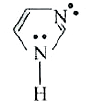Which of the following coordination compounds would exhibit optical isomerism and it is low spin complex
[Cr(en)3]+3
[Ni(gly)3]Θ
[Pt(bn)2]2⊕
All of these
The correct Answer is:C
To determine which coordination compound exhibits optical isomerism and is a low spin complex, we will analyze the given compounds step-by-step.
Step 1: Understand Optical Isomerism
Optical isomerism occurs when a compound can exist in two forms that are mirror images of each other (enantiomers). This typically happens in coordination compounds with bidentate ligands that create a chiral environment.
Hint: Look for bidentate ligands that can create non-superimposable mirror images.
Step 2: Identify the Ligands and Their Denticity
- E-end ligand: This is a bidentate ligand, which means it can bind to the metal at two sites.
- Glycine: This is also a bidentate ligand.
- Butane-2,3-diamine (Bn): This is another bidentate ligand.
Hint: Check if the ligand can bind at two different sites to form a chelate ring.
Step 3: Analyze the Metal Ions
- Cr³⁺: This has a configuration of 3d³. It can be a low spin complex depending on the ligand field strength.
- Ni²⁺: This has a configuration of 3d⁸. It typically forms high spin complexes with weak field ligands.
- Pt²⁺: This has a configuration of 4d⁸ and typically forms square planar complexes, which can be low spin.
Hint: Consider the electron configuration and the nature of the ligands (strong or weak field) to determine spin states.
Step 4: Determine the Spin State
- Cr³⁺ with strong field ligands can be low spin.
- Ni²⁺ with bidentate ligands like glycine typically forms high spin complexes.
- Pt²⁺ with bidentate ligands like Bn can form low spin complexes due to the square planar geometry.
Hint: Remember that square planar complexes with d⁸ configuration are usually low spin.
Step 5: Check for Optical Isomerism
- The E-end ligand and glycine can potentially create chiral complexes, but the specific geometry needs to be considered.
- The Bn ligand with Pt²⁺ can create a chiral environment, leading to optical isomerism.
Hint: Visualize the 3D structure of the complexes to see if they can be non-superimposable.
Conclusion
The coordination compound that exhibits optical isomerism and is a low spin complex is (Pt(Bn)₂)²⁺. This complex is formed with the bidentate ligand butane-2,3-diamine and is square planar, leading to low spin and optical activity.
Final Answer: The correct option is (Pt(Bn)₂)²⁺.
Optical isomerism occurs when a compound can exist in two forms that are mirror images of each other (enantiomers). This typically happens in coordination compounds with bidentate ligands that create a chiral environment.
- E-end ligand: This is a bidentate ligand, which means it can bind to the metal at two sites.
- Glycine: This is also a bidentate ligand.
- Butane-2,3-diamine (Bn): This is another bidentate ligand.
- Cr³⁺: This has a configuration of 3d³. It can be a low spin complex depending on the ligand field strength.
- Ni²⁺: This has a configuration of 3d⁸. It typically forms high spin complexes with weak field ligands.
- Pt²⁺: This has a configuration of 4d⁸ and typically forms square planar complexes, which can be low spin.
- Cr³⁺ with strong field ligands can be low spin.
- Ni²⁺ with bidentate ligands like glycine typically forms high spin complexes.
- Pt²⁺ with bidentate ligands like Bn can form low spin complexes due to the square planar geometry.
- The E-end ligand and glycine can potentially create chiral complexes, but the specific geometry needs to be considered.
- The Bn ligand with Pt²⁺ can create a chiral environment, leading to optical isomerism.
The coordination compound that exhibits optical isomerism and is a low spin complex is (Pt(Bn)₂)²⁺. This complex is formed with the bidentate ligand butane-2,3-diamine and is square planar, leading to low spin and optical activity.
Topper's Solved these Questions
- TEST PAPERSBOOK - ALLENCHAPTER - TEST PAPERSEXERCISE - CHEMISTRY
25 Videos
- TEST PAPERSBOOK - ALLENCHAPTER - TEST PAPERSEXERCISE - MATHEMATICS
2 Videos
- TEST PAPERSBOOK - ALLENCHAPTER - TEST PAPERSEXERCISE - part-2 Chemisty
18 Videos
- TEST PAPER 4BOOK - ALLENCHAPTER - TEST PAPER 4EXERCISE - CHEMISTRY
45 Videos
- THERMODYNAMICS BOOK - ALLENCHAPTER - THERMODYNAMICS EXERCISE - EXERCISE -4
18 Videos
Similar Questions
Knowledge Check
Which of the following compounds would exhibit aromatic properties?
A B
B C
C D
D
Which of the following compounds will exhibit geometrical isomerism?
A1-phenyl-1-buteneB3-phenyl-1-buteneC2-phenyl-1-buteneD1,1-diphenyl-1-propeneWhich of the following compounds will exhibit cis-trans (geometrical) isomerism?
ABut-2-eneBBut-2-yneCButan-2-olDBut-1-ene
Which is a low spin complex?
View SolutionWhich of the following compounds will exhibit geometrical isomerism?
View SolutionWhich of the following compounds will exhibit geometrical isomerism?
View SolutionWhich of the following compounds will exhibit geometrical isomerism?
View SolutionWhich of the following complex compounds does not exhibits cis-trans isomerism ?
View Solution
